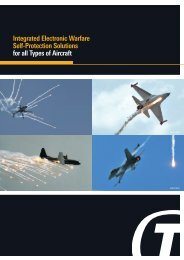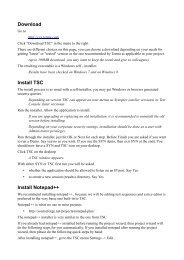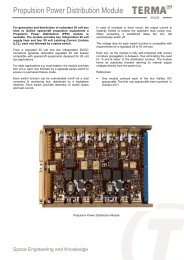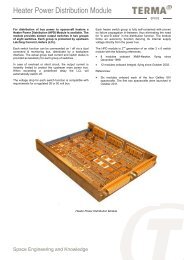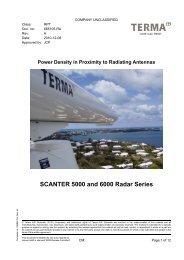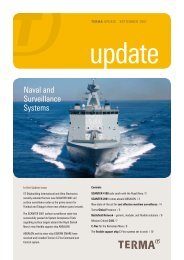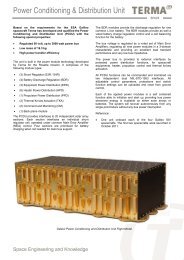3D-Audio for Helicopters - Terma
3D-Audio for Helicopters - Terma
3D-Audio for Helicopters - Terma
Create successful ePaper yourself
Turn your PDF publications into a flip-book with our unique Google optimized e-Paper software.
JUNE 2010<br />
www.terma.com<br />
<strong>3D</strong>-<strong>Audio</strong> & Active Noise Reduction<br />
Natural audio in noisy environments<br />
<strong>Terma</strong>’s <strong>3D</strong> intercom solution improves situational awareness by<br />
reducing noise and enhancing communication through use of<br />
<strong>3D</strong>-<strong>Audio</strong> and Active Noise Reduction technology.<br />
The enhanced situational awareness from applying <strong>Terma</strong> audio<br />
technology significantly improves reaction times, intelligibility and<br />
lowers the stress level of the pilot and crew<br />
- and hence increases mission effectiveness. By integrating <strong>3D</strong>-<strong>Audio</strong><br />
and Active Noise Reduction in the cockpit, audio communication<br />
can take advantage of our natural<br />
human ability to distinguish directional sound.<br />
<strong>3D</strong>-<strong>Audio</strong> or spatial audio is used in two ways to improve the<br />
situational awareness of the pilot: channel separation and<br />
directional in<strong>for</strong>mation.<br />
First, the spatial separation of radio channels intercom, and system<br />
messages allows the pilot to focus on one message or radio channel<br />
while still being aware of others. Pilot and crew members can avoid<br />
entering a communication overload stage, as known from<br />
mono-based intercom systems, where too much radio/intercom<br />
activity leads to total disregard of the audio communication.<br />
<strong>3D</strong>-<strong>Audio</strong> enables natural conversation on the intercom system<br />
between pilot, co-pilot, and crew members leading to more<br />
effective communication. Furthermore, the speakers will be<br />
identified by the direction of their voices making it easier to<br />
suppress background noise and irrelevant in<strong>for</strong>mation.<br />
When integrated with on-board sensors and head-tracking devices<br />
as found in modern helmet mounted cueing systems, <strong>Terma</strong>’s<br />
<strong>3D</strong>-<strong>Audio</strong> technology will further enhance situational awareness.<br />
Directional in<strong>for</strong>mation<br />
to the pilot – e.g.<br />
the direction of a<br />
threat – will be heard<br />
from the actual<br />
direction as indicated<br />
by the sensors, in<br />
correct relation to the<br />
listener’s head and<br />
aircraft position.<br />
<strong>Audio</strong> from the actual<br />
threat direction<br />
enables the pilot to<br />
faster – up to one<br />
second – understand where a threat is coming from and react.<br />
Another important feature of spatial audio is that a listener is<br />
aware of the full sphere, i.e. he/she notices sound from any<br />
direction. This is a major difference from visual indications on<br />
cockpit-mounted displays which require the viewer to direct his/her<br />
eyes towards the display. In fact <strong>3D</strong>-<strong>Audio</strong> is similar to helmetmounted<br />
type displays, which keep the in<strong>for</strong>mation available<br />
regardless of where the pilot is looking.<br />
In a similar manner, <strong>3D</strong>-<strong>Audio</strong> will<br />
keep the pilot updated if the threat<br />
changes direction relative to<br />
his/her own plat<strong>for</strong>m.
JUNE 2010<br />
idworks.dk 4867/06.10<br />
<strong>3D</strong> & Active Noise Reduction<br />
Aircrew also benefi t signifi cantly from Active Noise Reduction. Reduced cockpit noise<br />
lowers fatigue and stress during long missions while enhancing <strong>3D</strong>-<strong>Audio</strong> per<strong>for</strong>mance.<br />
Reduced noise levels also allow pilots to lower the volume of the intercom system, yielding<br />
signifi cantly reduced acoustical levels – and a chance to avoid the yellow earplugs.<br />
terma has achieved a reduction in noise exposure through the development of a digital<br />
ANR-headset powered through a standard intercom interface. the headset has outstanding<br />
noise attenuation and is at the same time capable of reproducing <strong>3D</strong>-<strong>Audio</strong>.<br />
the terma <strong>3D</strong>-<strong>Audio</strong> solution includes a <strong>for</strong>m-fi t replacement <strong>for</strong> existing intercom<br />
systems, including the amplifi er and the headset. Although designed <strong>for</strong> the F-16, the<br />
system can be integrated in other plat<strong>for</strong>ms, including the noisiest helicopter plat<strong>for</strong>ms.<br />
the terma solution which includes <strong>3D</strong>-<strong>Audio</strong> and Active Noise Production technology<br />
is fi elded on modern F-16s in support of the Royal Danish Air Force.<br />
Product Specification<br />
<strong>3D</strong>-<strong>Audio</strong><br />
Angular Resolution<br />
<strong>3D</strong>-<strong>Audio</strong> Channels<br />
<strong>Audio</strong> Management<br />
<strong>Audio</strong> Storage (audio cues)<br />
<strong>Audio</strong> Sample rate<br />
Analog Inputs<br />
Analog Outputs<br />
Headset Output<br />
Discrete Inputs<br />
Microphone Input<br />
Interface Control<br />
Max Sound Pressure Level<br />
Frequency Response<br />
Distortion<br />
HRTF Reproduction<br />
Noise Attenuation (active+passive)<br />
ANR<br />
Helmet Compatibility<br />
Helmet Kit Nominal Impedance<br />
Helmet kit Weight<br />
Operational Temperature:<br />
Storage Temperature:<br />
Vibration<br />
Electro-Magnetic<br />
Humidity<br />
Low Pressure (Altitude)<br />
Generic database of Head Related transfer-Function (HRtF).<br />
Full-sphere 1.5 degrees coverage<br />
Better than 3 deg azimuth and 10 deg elevation.<br />
(application dependent)<br />
8<br />
Play, stop, pause, priority, play list etc.<br />
512 mByte<br />
22 kHz – 48 kHz (internal sample Rate 48 kHz)<br />
9 channels<br />
3 (Record -, intercom - and command mic. out)<br />
4-wire standard to U-92 A/U connector<br />
Analog mode: output <strong>for</strong> standard intercom headset<br />
Digital mode: Powered Digital <strong>Audio</strong> (auto detection)<br />
4 (Hot-mic, Radios Keys and Analog/Digital mode)<br />
low impedance m-87 dynamic microphone and m-169<br />
microphone<br />
serial communication Rs-485<br />
115 dB (@tHD < 3 %, ANR oN)<br />
20 Hz – 16 kHz<br />
0.5 % (@ 85 dB, 1000 Hz)<br />
+/- 1 dB (63 Hz-16 kHz)<br />
20 – 30 dB<br />
9 dB (A), 20 dB (peak)<br />
HGU-55/P, JHmcs and HGU-56<br />
9.5 ohms (Analog mode)<br />
320 g<br />
EiA: -40°c – +71°c: Helmet kit: -40°c – +55°c<br />
EiA: -54°c – +95°c: Helmet kit:-40°c – +70°c<br />
EiA: Gun fi re: 15 g peak sinusoidal, 0.06 g 2 /Hz background<br />
random. method 519.5 of mil-stD-810F<br />
mil-stD-461 rev. E<br />
mil-E-5400t<br />
sea level – 50.000 ft.<br />
terma A/s<br />
Hovmarken 4<br />
8520 lystrup<br />
Denmark<br />
t: +45 8743 6000<br />
F: +45 8743 6001<br />
E: terma.dk@terma.com



